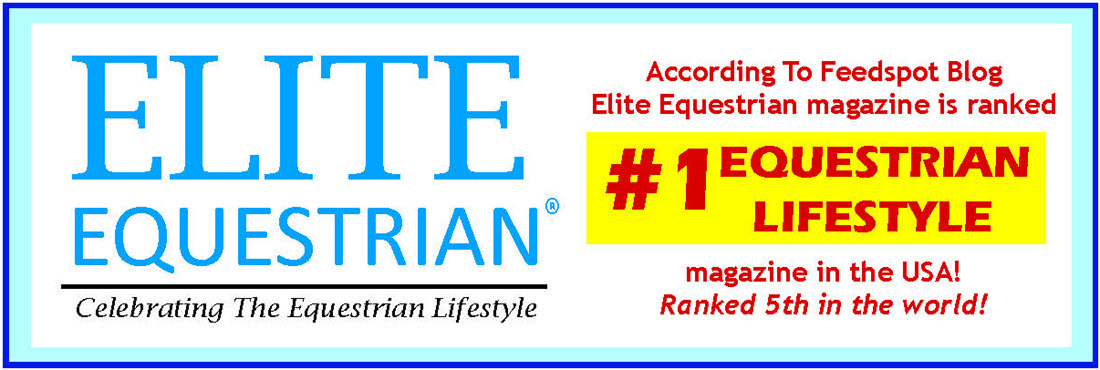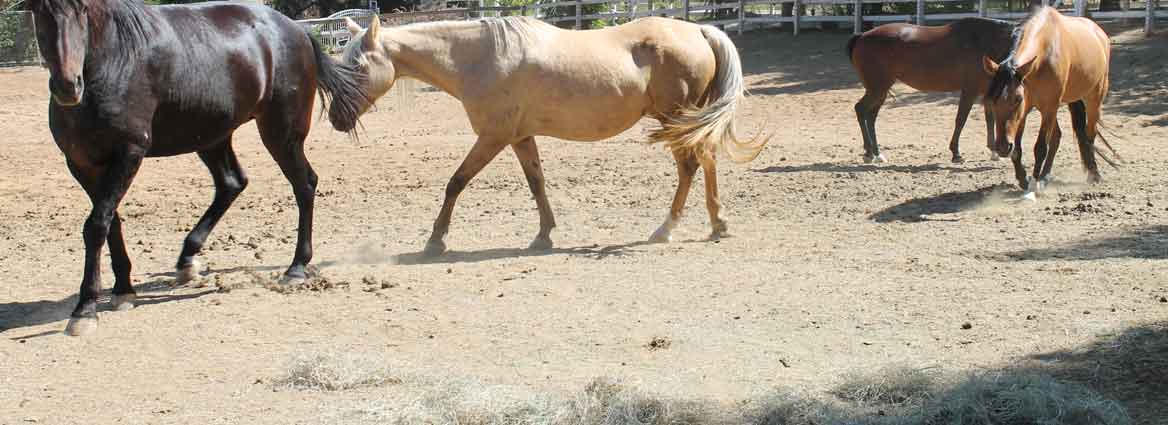
HORSEMANSHIP AND HORSEHORSESHIP
At Human to Horse, two of the things we always hold in high consideration in horsemanship, are social relationships and freedom. They are ethological needs for the equine species. We feel they are so important that, during the past two years, we accomplished a series of observations about, it in cooperation with Rancho de Los Cielos, a Mangalarga Marchador breeding farm in Riverside, California.
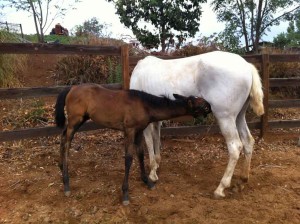
Our experiment was part of the plan we designed for the upbringing of Aria de Los Cielos, our Mangalarga Marchador filly born on may 1st 2012. We managed her environment closely from birth, giving her the chance to have social relationships and freedom of choice in her interactions with horses and humans, primarily aiming to develop a horse with a balanced mind.
Aria de Los Cielos, a real life experiment
I met Aria the day she was born, but in my mind I already had a picture of what she was going to be like. I was very fortunate to have the chance to work with both her parents. Aria is now two and a half years old, and we have structured her environment to prepare her to share her life with human beings in the future years. Certainly, this all sounds a bit egoistic of me, but isn’t it how life works for any domestic horse, or animal nowadays?
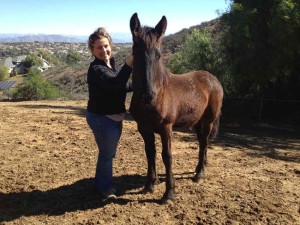
In Aria’s case, our focus was on the social aspect of breeding, which very seldom is considered important. We have kept in mind the social relationships, with other horses, and with human beings. We interacted with mare and foal, at any time of their life. The crucial points were: the birth, the introduction to a “mare and foal” herd, the weaning stage, the introduction to a herd of same age young horses and an adult mare, moving to a different farm with one of her last herd mates, making contact with the herd of adult mares at Rancho de Los Cielos.
Aria de Los Cielos was born in a small corral, then was moved to a bigger enclosure with other mares and foals for the first four months of her life. Particular care was taken in weaning her, which is a very critical moment that marks the end of the close relationship with the mother. This is also, sometimes, the only close relationship in a horse’s life. I strongly feel that separation anxiety is a byproduct of when foals get weaned in an inappropriate way.
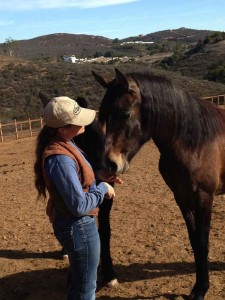
Aria’s mother is a submissive horse, that rarely engages in arguments. We do not know much about her past, but she was imported from Brazil at the age of five. In her native country the mares live in herds, with very little handling, until three years of age, when they get broke to ride and inspected to be approved for breeding purposes. The inspection is about their conformation, mind and gait, that is the main characteristic of the Mangalarga Marchador breed. The way Aria and the other mares live in Riverside is a very different reality from the one in Brazil, but we tried to preserve the social aspects of the way those horses are bred in their country of origin. I believe that this is a very important contribution to the development of a balanced mind in horses. One of the behaviors of horses with an imbalanced mind is their tendency to maintain distance from other individuals, when they try to relate to them in a direct way and not necessarily threatening to them. Even in our own human species, individuals that are not used to be near others have difficulty when they are approached. Horses that have this kind of behavior could have stress problems, if forced to live in a herd.
The herd of mares at Rancho de Los Cielos
The group of mares at RDLC is a stable group of Mangalarga Marchadores, and at times includes foals. The group has a solid “pecking order”, because of the length of time they have lived together, and have shared any and every aspect of life. Between the mares, there is always an active and silent dialogue. They eat, drink, sleep, pay attention to the surrounding activity, in a way that builds a connection between them. This allows to discuss and resolve all the possible problems of their relationship.
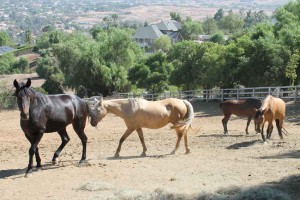
Aria meets the herd at RDLC
In September 2014, after being away from the farm for over a year, Aria de Los Cielos was reconnected with the herd of RDLC mares for a short period of time. During her time away Aria was at a different farm, in a large paddock, with Luca, a Friesian filly part of the herd she joined after being weaned. Both fillies have been interacting with me since birth, first without tack, then with a flat, soft padded, English halter. I took them to the point of beginning to use the longe line and work on a circle path (Youtube: Beginning longeing with Aria de Los Cielos http://youtu.be/k41O-OR6boc ).
The reasoning for having Aria rejoin the herd was that we wanted to see how she would behave in such a complex social situation. I decided that she could have successfully faced this situation because of how she behaved in the previous groups. A brief video of the encounter, published on Youtube, shows how Aria has good manners, and puts herself on the lowest level of the pecking order of the herd of adult mares (Youtube: Introducing a young horse to a herd. http://youtu.be/iSRKIQkZyf4). There was no argument, just a polite, silent dialogue, revolving around food. The mares live on a typical “dry lot”, the feeding happens with piles of hay in a number that is larger than the horses present, and distanced enough to let them comfortably eat. Aria never showed submission, with the typical act of the young and inexperienced horse, that chews the air smacking its lips. At times, such behavior sticks with the individuals, if they do not get the chance to learn to live in a group.
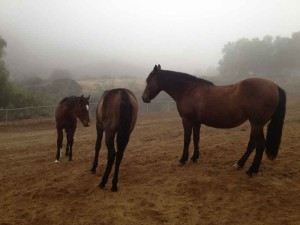
Another fact we had the chance to observe was the confidence that young Aria showed while going from one group of horses to another, immediately relating to them without anxiety. We also tried leaving her alone in a paddock, and noticed that she did not like the situation, and that she was looking for other horses. Her behavior was controlled, she did not run or vocalized, instead she was walking the perimeter, looking for an opening to go close to the other horses.
Aria is now approaching the time in which domestic horses go from living with a group of cospecific individuals to relating to people through horsemanship. We do not yet have solid elements to evaluate the results of our decisions in Aria’s upbringing, but there is a very promising fact: if I enter her visual field or call her, she looks at me, leaves her herdmates to approach the fence and wait for me to get up to her.
Rancho de Los Cielos
Rancho de Los Cielos is horse breeding farm, nestled between orange groves and nurseries, on the hills of Riverside, Ca. Dr Therese Longo and her husband Jacob Martinez, owners of RDLC, are breeders of Mangalarga Marchador horses. This is a Brazilian breed of naturally gaited horses, that has another very desirable trait, a particular affinity to bonding with people.
Human to Horse and RDLC have developed a horsemanship program that covers the entire span of the horse’s life, and is also aimed to make this particular breed of horses known to the public. A visita to the ranch allows anyone to get in close contact with horses of all ages and gender, to appreciate the qualities that the Mangalarga Marchador has to offer to its human partner.
Contact us for further information at HumantoHorse@me.com .
About H2H
In training your horse do not guess, lead!
We will be there for you and your horse. H2H is dedicated to enhance your horse’s potential keeping his wellbeing and yours in mind.
Aside from training, we provide you and your horse with the solid horsemanship foundation you need to be successful in any equestrian discipline. Solid horsemanship allows us to take challenges that we would not imagine being possible even with good traditional training.
With H2H Sensing, human being and horse work together freely, with or without tack, through how they perceive the situations. It works whether just starting or repurposing a horse, at any time of his life. We teach human and horse how to establish an active and dynamic dialogue that will assist them throughout any situation. Your horse can execute without being submissive and you can become a leader of leaders.
H2H Services: horse training, problem solving, horsemanship instruction through private sessions, tutorials, phone consultations, workshops, Horse & Rider sessions, online classes and gift certificates.
H2H Clinics: we offer different formats of clinics, at our location or anywhere you desire, call us and inquire for dates.
Events: Contact us if you have an event and would like us to hold a clinic to enhance it.
H2H contact: 7607151554 http://www.humantohorse.com humantohorse@me.com
We are still working on the 2015 Clinic Calendar, contact us to book a clinic at your location. Prices will vary according to location.
